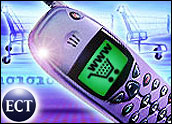
Trends are often difficult to get a handle on, especially those that gauge consumersentiment. The best you can hope for is a snapshot of a moment in time, and people havea tendency to change their minds without notice.
But I put a lot of stock in survey-driven news that the level of interest among consumersin shopping via cell phone has plummeted.
One survey found that while 76 percent of respondents said they were “very likely” toshop via cell phone in 2000, that number fell to about 50 percent in 2001 and is nowwell below 25 percent.
If you’re banking on m-commerce(remember when you couldn’t go an hour without hearingthat phrase?), this is disheartening news. But it is not the end of the world forwireless commerce. The future might not be sunshine bright, but there are breaks in theclouds.
Win Some, Lose Some
Indeed, if people were ready to make purchases using wireless phones in 2000, theyprobably got tired of waiting for retailers to provide something they could buy.
Now the technology exists, but demand has shriveled from neglect. That’s anoversimplification, but it’s not that far off. So, how can consumer interest be revived?
For a host of psychological and economic reasons, consumer demand for m-commerceprobably will never return to 2000 levels. But purveyors of this technology canstart by building a logical foundation.
It seems to me that the first generation of m-commerce hoopla was all about providingthe ability to buy anything, anywhere, anytime. As it turns out, people do not need todo that, although when they had disposable income to burn, they thought they might liketo try.
LIttle by Little
So, now come the baby steps. Mobile e-commerce players must identify what will work andstart by spoon-feeding consumers small bites.
Where to begin? Start by asking what people really need to buy on a moment’s notice.
EBay’s mobile alert service, announcedlast week, is an excellent example. Because of its ever-changing nature, the eBaybidding and buying experience is ideal for wireless alerts.
You get outbid, you get an e-mail. If you’re not near a computer and don’thave such a service, it might be hours before you know your bid has been trumped.
Constant Change
There, an element of mobile commerce makes sense. Where else? How about in the risingtide of overstock and closeout merchandise retailers?
Presumably, what these e-tailers offer for sale changes constantly, and their ability tooffer bargains depends on what is in stock or on what a retailer wants to get rid offast. I can easily envision bargain-hunting consumers signing up to get first crack atcloseout merchandise — along with a special discount, of course.
Amazon, too, has often tossed them-commerce beanbag into the air — and books, music and movies might be a logical choicefor m-commerce.
The idea is that the products offered for sale constantly change. There is somethingabout being the first to own something that makes speed matter. Just check out a recordstore at midnight when a U2 CD goes on sale.
Keeping It Real
The point is that the mobile element has to be relevant. We’re not yet at a point whereretailers can alert us via cell phone that sweaters are on sale when we drive by a store.But that’s the kind of relevance that is required.
It won’t happen overnight. It seemed as though it would at first, but now reality has setin. It’s time for m-commerce to get in line with the rest of the recovering tech worldand learn to crawl before it starts to run.
What do you think? Let’s talk about it.
Note: The opinions expressed byour columnists are their own and do not necessarily reflect the views of the E-Commerce Timesor its management.






















































Now, Keith…..I get the impression that you are AM ong the cell and wireless users who actually do shop via your phone. As for me, I would not even attempt to do so, in a shopping mode – searching AM ong many vendors looking for a deal – with a phone, not even a high-speed (?) PDA-equipped unit. Why? Because the shopper is trying to do on a little screen what is much more convenient when using a larger screen, such as on a laptop.
If I needed something, really in a hurry, and only had a phone to use, I would do a quick search for a vendor that would probably stock the item and then use the phone’s voice feature (duh) to call them and place the order. Who wants to attempt shopping with slow load times, on expensive airtime, with a display that is hard to read? I don’t believe e-commerce and cell/wireless phones are really compatible, in terms of the written word shopping.
Another survey just released this week says the normal e-commerce is doing just fine, which means that people are actually using their laptop or desktop machines to go to market. We need speedy service, ease of finalizing transactions and really smart customer service.
jimmyshoe, have you heard of paypal? Point your mobile phone to x.com.
You can pay for just about anything with your mobile phone using paypal. enjoy!
Guys, I don’t understand why the E-bay article seems to be attracting so much attention. As an avid auction seller and bidder, I have been using their mobile alerts feature for years. Actually, it appears like the author of this article didn’t even do any research, since Amazon.com has had outbid alerts, you’ve won alerts, your item has sold alerts, the ability to up-a-bid, and the ability to purchase fixed-priced items from cell phones since 2000.
What gives? Why all the hoopla now?
I don’t see this becoming a viable technology unless I can charge the purchase to my phone.